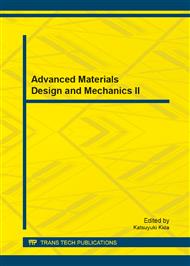[1]
Y. Liang, N. Hilal, Interaction forces between colloidal particles in liquid: Theory and experiment, Advances in Colloid and Interface Science 134 (2007) 151–166.
DOI: 10.1016/j.cis.2007.04.003
Google Scholar
[2]
T. Miettinen, J. Ralston, The limits of fine particle flotation, Minerals Engineering 23 (2010) 420–437.
DOI: 10.1016/j.mineng.2009.12.006
Google Scholar
[3]
Z. Dai, D. Fornasiero, J. Ralston, Particle–bubble collision models — a review, Advances in Colloid and Interface Science 85 (2000) 231-256.
DOI: 10.1016/s0001-8686(99)00030-5
Google Scholar
[4]
S. Yang, R. Pelton, A. Raegen, M. Montgomery, K. Dalnoki-Veress, Nanoparticle Flotation Collectors: Mechanisms Behind a New Technology, Langmuir 27 (2011) 10438–10446.
DOI: 10.1021/la2016534
Google Scholar
[5]
R.H. Yoon, The role of hydrodynamic and surface forces in bubble–particle interaction, Int. J. Miner. Process. 58 (2000) 129-143.
Google Scholar
[6]
D.I. Verrelli, P.T.L. Koh, Particle–bubble interaction and attachment in flotation, Chemical Engineering Science 66 (2011) 5910-5921.
DOI: 10.1016/j.ces.2011.08.016
Google Scholar
[7]
G. Bozzano, and M. Dente, Shape and terminal velocity of single bubble motion: A novel approach, Computers & Chemical Engineering 25 (2001) 571-576.
DOI: 10.1016/s0098-1354(01)00636-6
Google Scholar
[8]
N.M.S. Hasan, M.M.K. Khan, M.G. Rasul, A Study of Bubble Trajectory and Drag Co-efficient in Water and Non-Newtonian Fluids, WSEAS Transactions on Fluid Mechanics 3 (2008) 261-270.
Google Scholar
[9]
J. Magnaudet, M. Rivero, Accelerated flows past a rigid sphere or a spherical bubble. Part 1. Steady straining flow, Journal of Fluid Mechanics 284 (1995) 97-135.
DOI: 10.1017/s0022112095000280
Google Scholar
[10]
N. Hasan, Comparison of a computational model of single bubble collection efficiency in a hallimond tube, Seventh International Conference on CFD in the Minerals and Process Industries CSIRO, Melbourne, Australia (2009).
Google Scholar


